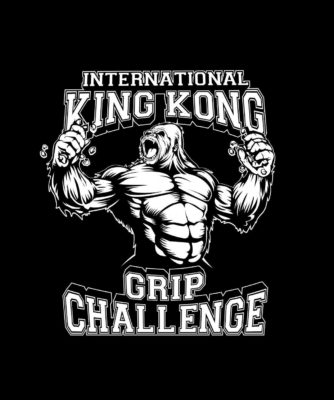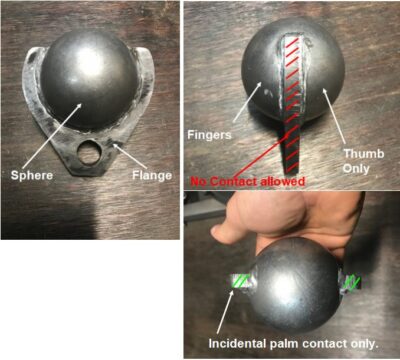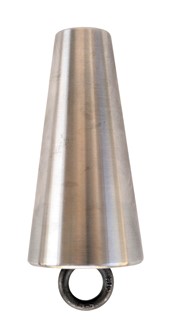

1 Event Overview
An international grip sport contest consisting of four distinct events:
- 2.25” FBBC Crusher
- Grab Ball
- Finnish Ball
- Little Big Horn (IronMind)

The Training Hall by Odd E. Haugen
996 Lawrence Drive, Newbury Park, California
Contest Date: October 17th, 2021
Weigh in 8:00 am
Rules Meeting 9:30 am
Lifting Start 10:00 am
Divisions:
-
Men’s 59 kg / 66 kg / 74 kg / 83 kg / 93 kg / 105 kg / 120 kg / 120+ kg
Women’s 57kg/72 kg / 84 / 100 / 100+ kg
Men’s 50+ Years Open
Divisions not officially offered in the contest will still be tracked for GSI records purposes (www.gripsport.org).
Awards:
Custom King Kong gorilla sculptures for the following:
- All class champions
- The overall top lifter in each event
- The Exceptional Lifter (best pound-for-pound performance – using a calculation developed by Andrew Pantke)
- The overall champion (“The King Kong of Grip”)
Custom gorilla medals for 2nd and 3rd place finishers in each class
Scoring: Reverse strongman scoring will be used.
2 Scoring
Scoring: Reverse strongman scoring will be used (as done in previous years). Andrew Pantke will tabulate the scoring once all completed scoresheets have been submitted by promoters.
Example of reverse strongman scoring:
If there are 10 athletes, then it would be 1 point for 1st and 10 points for 10th.
All the points are added up at the end. The person with the lowest score is the winner. If the points are equal at the end of the contest, then the placings are found by using the count-back method. This is giving the position to the person with the most amounts of wins. If it is still a tie, then you look at the most amount of 2nd places, and then 3rd, 4th, and so forth till there is a winner. If two athletes are level in say 4th place, then they would receive 4.5pts each (4 plus 5 points are added together and halved). If, after using the count-back method there is still a tie, the person with the lower bodyweight wins.
3 General Rules
All competitors must weigh in on a point calibrated or certified calibrated scale no earlier than two hours before the start of the competition.
Either competition weight plates or weight plates that have been weighed on a calibrated scale are to be used. All devices must have been weighed on a calibrated scale as well.
The crossbar is set at the height determined by the promoter that allows for the correct height for each event. Lift heights will vary by event.
All venues must run the events in the same order:
- 1st – 2.25” Crusher
- 2nd –Grab Ball
- 3rd – Finnish Ball
- 4th – Little Big Horn
The competitor can switch hands at any time, as desired.
Each competitor is allowed four (4) trips to the platform for official attempts. On each trip, the competitor has one (1) minute during which he/she can make as many attempts as desired. The one-minute time limit also includes equipment prep time (i.e. adding or removing chalk to one’s liking). Chalk can be removed using a dry cloth, paper towels, or equivalent, provided by the venue promoter.
The amount of weight attempted must rise or stay the same for each subsequent trip to the platform.
Warm-ups can be made on the contest apparatus prior to official attempts, but must be declared as such to the referee. However, once a competitor has begun his official attempts, he may no longer do warm-up lifts on the contest apparatus. Promoters may refuse warmups on the contest apparatus assuming a suitable warm up station has been provided.
Individual athletes will have a minimum of two (2) minutes between their trips to the platform, with the maximum at the discretion of the local promoter.
4 Personal Equipment Specifications
Clothing: Clothing will consist of trousers, shorts or a skirt for a woman for the lower half. For a top a t-shirt, sweatshirts or long-sleeved shirts may be worn after showing that no illegal bracing
is worn on the wrists or elbows. One piece lifting suits are allowed. Gloves are not allowed to be worn when lifting. No inappropriate writings or pictures are allowed.
Belts: Lifting belts are allowed and may be of rubber, nylon, or leather.
Wrist Wraps: Wrist wraps/bands of any kind are not allowed.
Elbow Sleeves: Non-adjustable elbow sleeves are allowed.
Knee Sleeves: Knee sleeves and/or braces are allowed.
Wraps/Bandages: Contingent upon prior approval by the Referee medical tape may be applied to bodily injuries in a fashion that would not grant the lifter an undue advantage.
Only chalk is allowed on the lifter’s hands. No foreign substances may be applied to the equipment. Liquid chalk is not permitted. This takes into account all substances other than chalk, or a sterile agent which may be used periodically in the cleaning of the equipment, or platform.
5 Event-Specific Rules
5- FBBC 2.25” Crusher
An authentic FBBC Crusher will be used for the event. The crusher will be cleaned and oiled per the manufacturer’s specifications the week prior to the event. The lift height for the event will be a 6” lift.
Only the handle is to be grasped with the fingers on one side, and the thumb opposing on the other side. A thumbless grip is not permitted. No hook grip (i.e. index finger wrapping thumb tip) is permitted even if the athlete has the hand span to do so.
The lifter grabs the Crusher in the center of the handle. In contests, promoters may mark the center of handle with a permanent marker. The handle is to be lifted level with a minimal amount of tilt. The athlete’s hand must not come into contact with the metal from of the crusher nor shall the crusher be allowed to be braced on any part of the athlete. A simple check is that no part of the painted portion on the crusher can come into with any part of the lifter.
The lifter will lift the Crusher until the crossguard touches the crossbar. There is no referee’s signal. You do not have to be erect upon completion. You must lower the weight under control (hand grasping it all the way down). If the lifter misses contact with the crossbar, the lifter will still need to have the top of the crossguard cross the plane of the crossbar. Referee’s discretion will be used to judge whether the correct height was attained.
The off-hand may not be placed in contact with device during any part of the attempt. During the lift it can be posted on the hip or leg or left out to the side.
5-2 Grab Ball
An authentic FBBC Grab Ball will be used for the event. The ball must not be modified
or painted and must remain in the factory unpainted condition. The lift height for the
event will be a 6” lift.
The Grab Ball must be lifted approximately level with intentional tilting of the device not
allowed. The ball or lifting hand may not come in contact with the lifters body or outside
object during the lift.
The Ball will be lifted with a single hand. The thumb will be on a single side of the
sphere with the fingers on the opposite side as shown in the above picture. So long as this
basic requirement is met, different types of grips/finger placement are allowed but there
must be no contact with the edge of the flange (see the no contact area marked in red in
the above picture). Contact with the face of the flange is acceptable, as is the top edge of
the flange (marked in green), but fingers may not go into the hole where the carabiner is
attached.

The off-hand may not be placed in contact with device during any part of the attempt.
During the lift it can be posted on the hip or leg or left out to the side.
There is no referee’s signal. You must lower the weight under control (hand grasping it
all the way down). If the lifter misses contact with the crossbar, the lifter will still need to
have the top of the crossguard cross the plane of the crossbar. Referee’s discretion will be
used to judge whether the correct height was attained.
Video demonstration of acceptable grips: https://www.youtube.com/watch?v=povCouE_jS0
5-2 Finnish Ball
Only the Ball is to be grasped with the hand in a key-pinch style (vertically pointing downwards thumb opposing the fingers).
No ‘doorknob’ style lifting allowed.
The lift height for the event will be 13” to align with currently tracked records.
There is no referee’s signal. You do not have to be erect upon completion. You must lower the weight under control (hand grasping it all the way down). If the top accidentally touches the bar before the weight itself, referee’s discretion will be used to judge whether the correct height was attained.
You must not intentionally tilt the apparatus to gain leverage.
5-4 IronMind Little Big Horn
NOTICE: The following rules differ from the IronMind Rules
The current version of the Little Big Horn should be used.
Current Version

The Little Big Horn is to be attached to the loading pin with a carabiner. It cannot be attached directly to the loading pin (i.e. not in the way that the Flask is attached to the loading pin). The lifter grips the Little Big Horn with one hand (no part of the hand can grasp below the rim). The lifter will lift the Little Big Horn until the crossguard comes in contact with the crossbar for a 6” lifting height. If the lifter misses contact with the crossbar, the lifter will still need to have the top of the crossguard cross the plane of the crossbar, referee’s discretion will be used to judge whether the correct height was attained.
There is no referee’s signal. You do not have to be erect upon completion. You must lower the weight under control (hand grasping it all the way down).
The off-hand may not be placed in contact with device during any part of the attempt. During the lift it can be posted on the hip or leg or left out to the side.
NOTE: Promoters are allowed to take steps to secure the LBH eye bolt in place. An issue has been raised whereby a left-handed lifter who applies rotation could conceivably have an advantage over right-handed lifters. This is due to the nature of the eye bolt used in the LBH. A right-handed lifter who attempts to increase friction with rotation could feasibly unscrew the bolt, whereas a left-handed lifter could not. If this is a concern to promoters, thread-locking fluid (or equivalent measures) can be used.
6 Loading Pins and Crossbars: Overview
Example Set-Up 1
Example Set-Up 2
The following sections will discuss the support equipment for the event. Moving forward the loading pins and crossguard will not have a specific requirement but a set of guidelines that must be followed. The uprights and crossbar/crossguard allow for a great deal of freedom for the promoters. Promoters may choose to use an adjustable crossguard or an adjustable crossbar. Either method of judging height can be used for King Kong as long as the specific event’s lifting height can be accurately gauged.
NOTE: The simplest method may be to place the crossguard at the bottom of the loading pin for all four events, and then to simply adjust the height of the crossbar for each event. However, this may not be the safest method: the crossguard can tend to swing during the lift for certain events (e.g. the Little Big Horn), and when the weight is put down the crossguard could come down on the athlete’s foot.
Loading Pins:
- ● Pin height should be between 11” and 16” inches tall.
- ● Loading pins can be no smaller in diameter than 1.9”
- ● Promoters are highly encouraged to have a backup loading pin in the case the main pin breaks during the event. It has happened in the past.
- ● The following pins are examples that meet the above criteria. As long as the criteria is met, any loading pin is fine.
- ○ FBBC Contest and Omni Pins
- ○ Barrel Strength Loading Pins
- ○ IronMind Loading Pin
Crossguards:
- ● Must be a rigid material that protrudes perpendicular from the loading pin. The Cross-guard must extend past the plates that will be used at the event to be able to hit the crossbar.
- ● Cross-guards can be adjustable in position.
- The following crossguards is an example that meets the above criteria. As long as the criteria is met, any crossguard is fine.
- FBBC Cross-guard
- FBBC ultra light Cross-guard
Crossbars and uprights:
- ● Provide a non-rigid height gauge for the crossguards to come in contact with.
- Uprights can be made of any material that allows the Cross-Bar to sit at the desired height.
- Homemade versions are allowed for this.
- ● The following cross-bar and uprights set-up is an example that meets the above criteria. As long as the criteria is met, any cross-bar and uprights set-up is fine.
- Barrel Strength competition crossbar.
Standing blocks
- ● In the case where an athlete cannot reach the height requirements comfortably, blocks or weight plates should be available for the athlete to stand on.
AT THE PROMOTER’S DISCRETION: It is permissible for lifters to start lifts with the loading pin placed on something higher than the floor (e.g. a small stool, extra mats, etc.), as long as everything else is also adjusted (i.e. crossbar) to ensure the range of motion requirements are met.
Example Block to stand on.
7 Social Media
With King Kong being an international multi-venue contest, not all venues will be running the contest at the same time. If athletes post scores or video prior to all individual contests being completed, it is possible for some athletes to use this information to influence their weight attempt selections and have an advantage. For this reason, we discourage the posting of attempts, scores, or video until all venues have wrapped up – ideally until official results are posted. However, no penalties will be incurred if this guideline is ignored. We are relying on venue promoters to explain to the athletes why they would want to hold off posting on social media, as it can only hurt their scores.
8 Compliance, Ethics and Penalties
Compliance:
This section is to clarify the expectations of the promoters and athletes taking part in the International King Kong Grip Challenge.
- The promoter will be familiar with all the general rules and individual event rules as laid out in this document.
- The promoter will enforce the event rules.
- The promoter will only use equipment from the designated supplier (i.e. an authentic Barrel Strength Flask, an authentic FBBC 2.25” Crusher, an authentic FBBC Grab Ball, and an authentic IronMind Little Big Horn).
- The promoters will ensure that all equipment has been maintained and serviced to the manufacturer’s specification. Damaged equipment must not be used in any circumstance.
Ethics:
Due to the number of variables it would both be impossible and impractical to list out each and every situation that could gain an athlete an advantage. The International King Kong Grip Challenge is unique to other contests in that athletes are competing with athletes in multiple locations around the world. The goal for each promoter should be to maintain uniformity to the best of their ability. The nature of grip is that a 100% uniformity would be impossible without everyone in the world lifting on the same equipment on the same day. This said, any action taken by a promoter to gain an advantage for themselves of their athletes can result in penalties being levied against the location even if no direct rule was broken. Not only will the letter of the law be enforced but the spirit as well.
Warnings and Penalties:
Let us first and foremost state that we have no desire to ever need to implement the following penalties but as the contest grows the chance that something will come up increases. This will set down a guideline for what will happen in the case of unethical conduct to outright cheating. When something off is noticed, the impact to the overall integrity of the contest is what will primarily be considered in determining the penalty level.
Warning: In a case where the offence does not impact the integrity of the contest and would not have within reasonable certainty affected the outcome the venue or person the venue will receive a warning. The immediate effect will be a discussion on how to move forward and eliminate this problem from future events. In the case that a venue or person receives a related or repeated minor penalty the following year, the offence will be upgraded to a moderate penalty.
Examples:
- Several missed calls (e.g. repeatedly not noticing when an athlete is not following the rules (for example intentional body contact)).
- Allowing an athlete to compete wearing a wrist band.
Moderate Penalty: In the case that an offence does have a measurable impact to the contest that would give the athletes a measurable advantage, yet the offence is not serious enough to warrant a major penalty. In this case the contest promoter along with the top 2 to 5 athletes at the location will take a 25% reduction in lifting scores. This will be evaluated on an event-by-event basis. If in doubt it will be applied to all 4 events. This will ensure that promoters that are not competing will not have the incentive to cheat to gain an advantage for their athletes. As well as putting ownership on the athletes themselves to keep an eye out for any issues that could appear. The reason this will not apply to all the athletes is for two reasons. First the top athletes are normally the most experienced and will be able to catch any cheating and puts their scores on the line to discourage cheating. Second punishing most of the athletes at the venue that would not affect the top scores could discourage newer athletes.
Examples:
- Not using authentic equipment (e.g. a horn other than an IronMind Little Big Horn)
- Using equipment that is damaged or not working properly
Major Penalty: In the case that an offence has a major impact across the contest site that would give the athletes a major advantage the entire location will be forced to take a zero. This would be considered blatant cheating.
Examples:
- Falsifying scores
- Using fake weights
Note that the venue promoter bares most of the responsibility for ensuring all rules are followed. This said, individual athletes can be removed from the competition at the venue promoter’s discretion. For example, if an athlete refuses to follow instructions after being told several times, he/she can be ejected from the competition.

